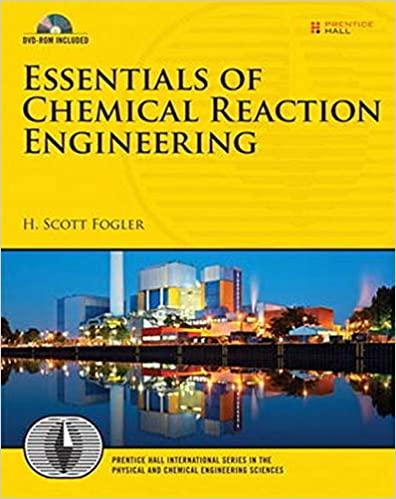Course:Chemical Engineering
Subject:Chemical Process Principles 2
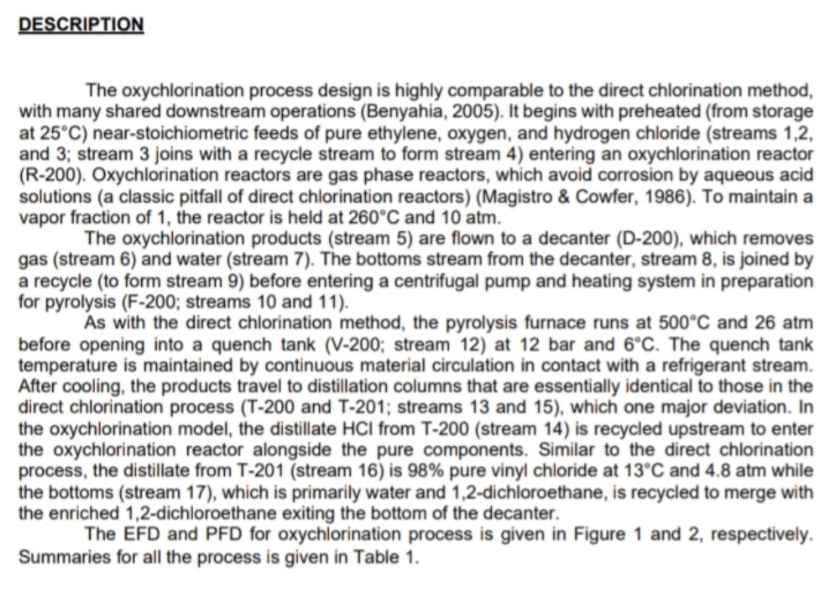
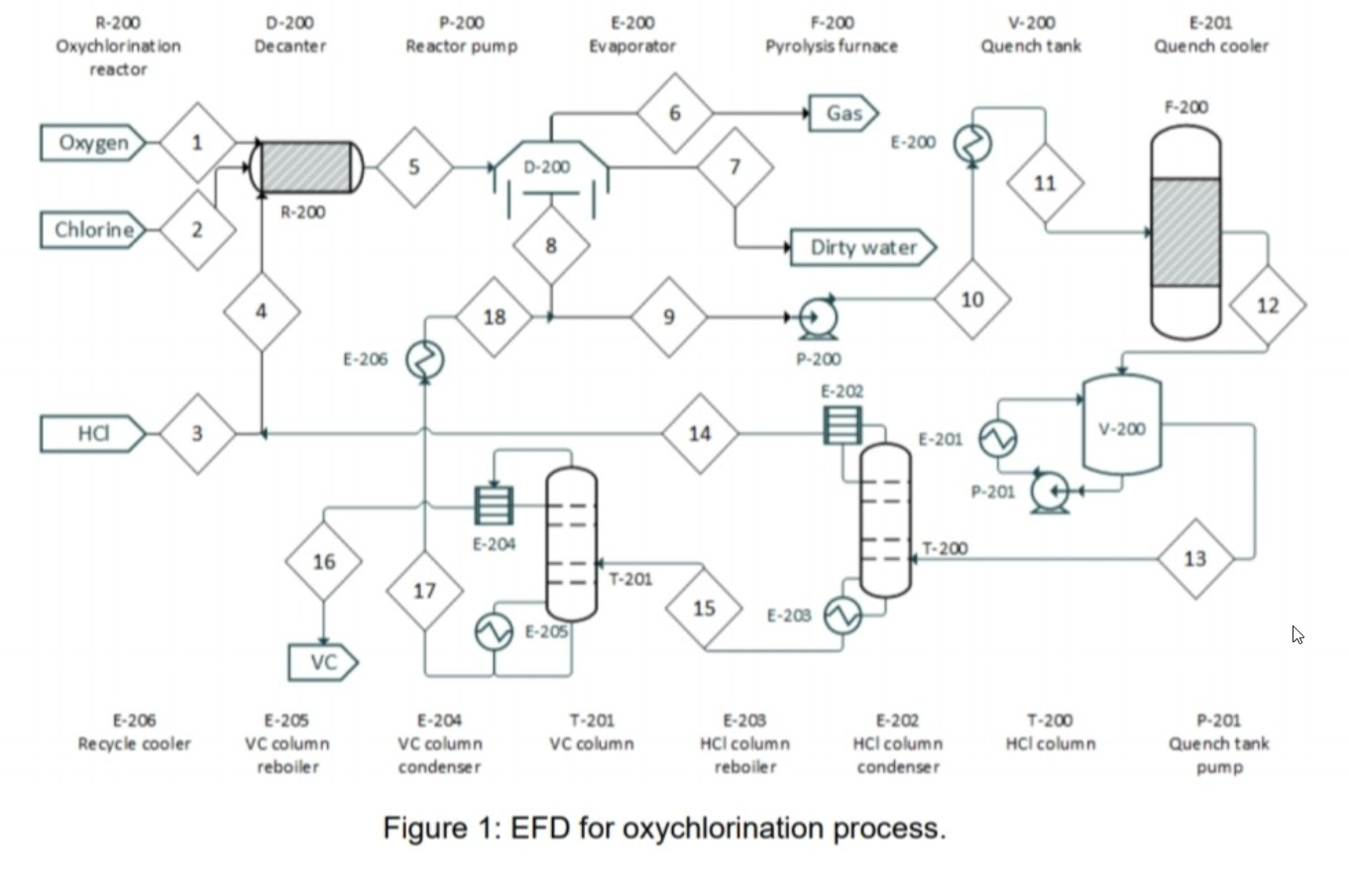
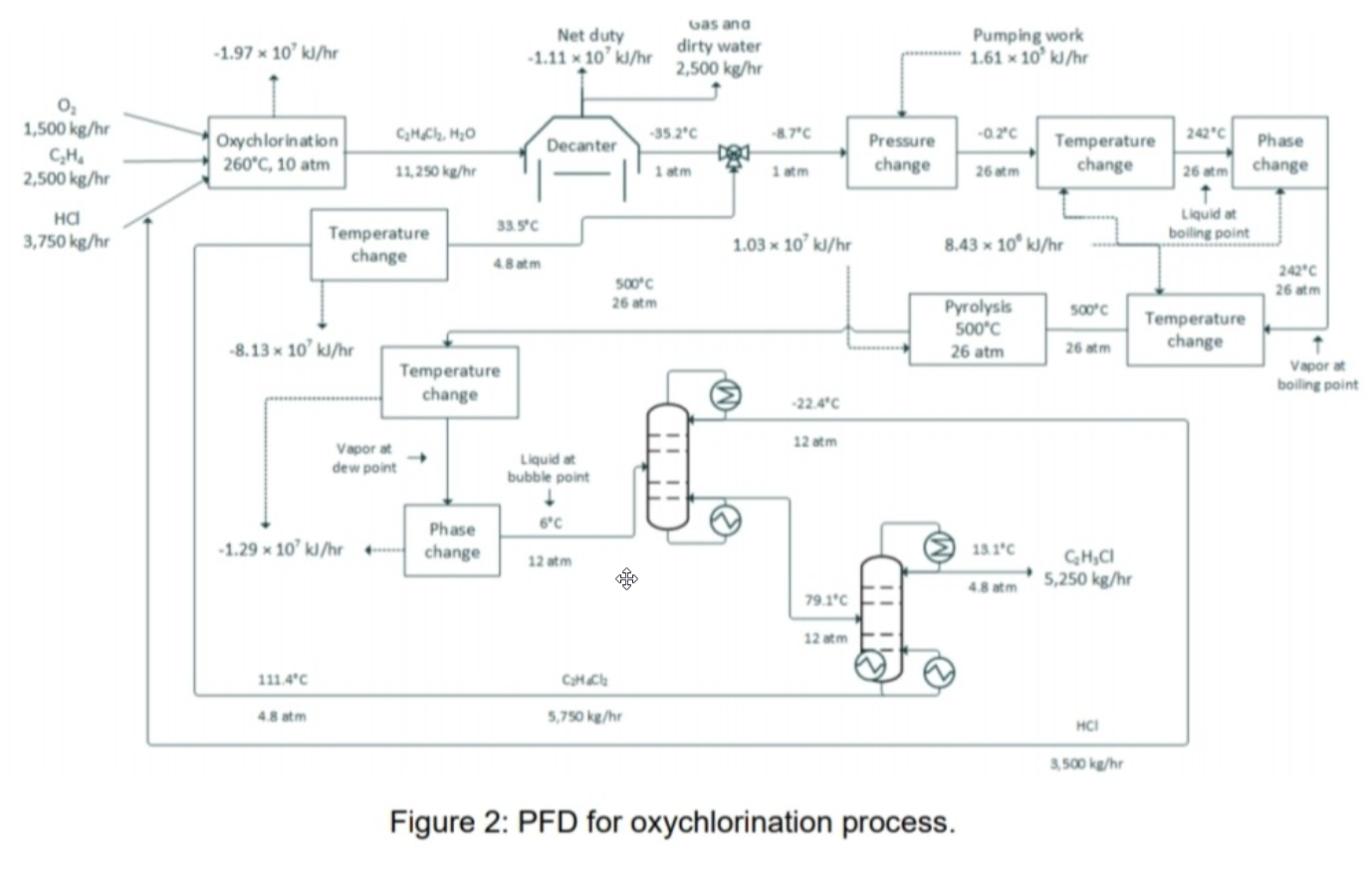
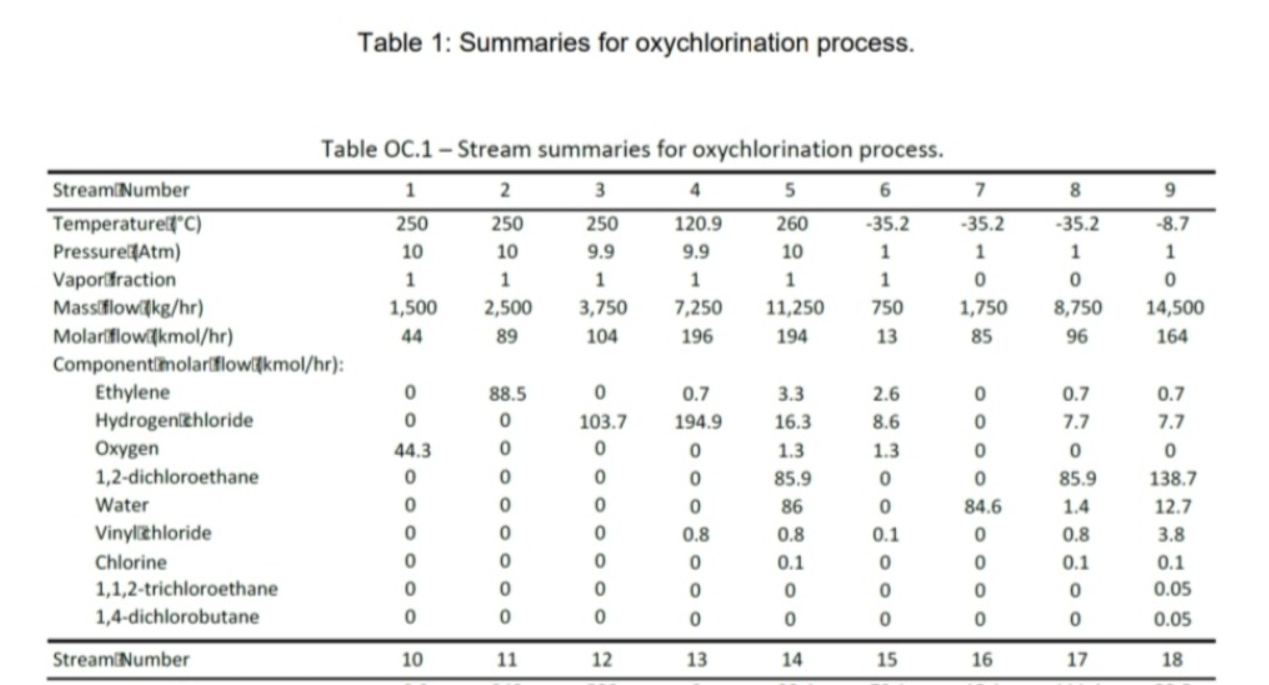
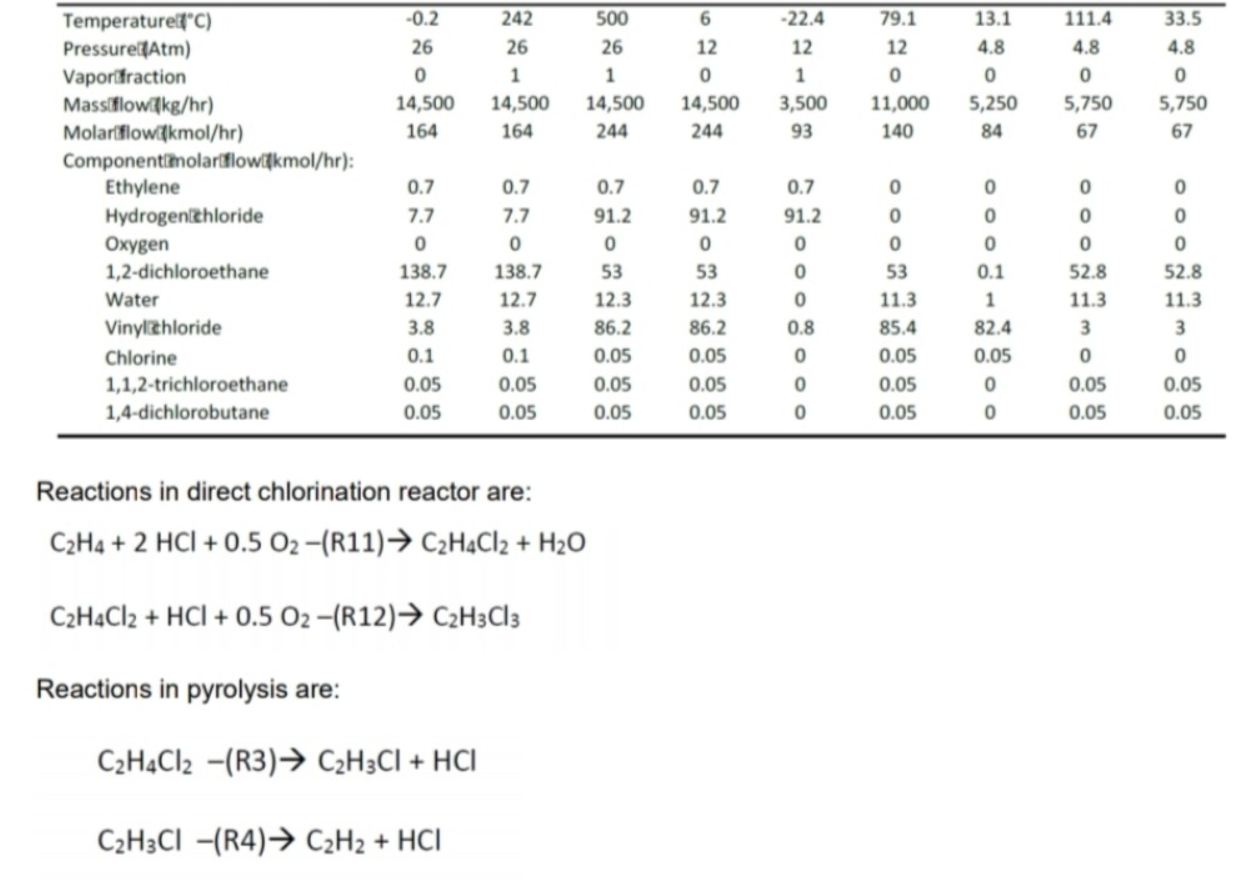

DESCRIPTION The oxychlorination process design is highly comparable to the direct chlorination method, with many shared downstream operations (Benyahia, 2005). It begins with preheated (from storage at 25C) near-stoichiometric feeds of pure ethylene, oxygen, and hydrogen chloride (streams 1,2, and 3; stream 3 joins with a recycle stream to form stream 4) entering an oxychlorination reactor (R-200). Oxychlorination reactors are gas phase reactors, which avoid corrosion by aqueous acid solutions (a classic pitfall of direct chlorination reactors) (Magistro & Cowfer, 1986). To maintain a vapor fraction of 1, the reactor is held at 260C and 10 atm. The oxychlorination products (stream 5) are flown to a decanter (D-200), which removes gas (stream 6) and water (stream 7). The bottoms stream from the decanter, stream 8, is joined by a recycle (to form stream 9) before entering a centrifugal pump and heating system in preparation for pyrolysis (F-200; streams 10 and 11). As with the direct chlorination method, the pyrolysis furnace runs at 500C and 26 atm before opening into a quench tank (V-200; stream 12) at 12 bar and 6C. The quench tank temperature is maintained by continuous material circulation in contact with a refrigerant stream. After cooling, the products travel to distillation columns that are essentially identical to those in the direct chlorination process (T-200 and T-201; streams 13 and 15), which one major deviation. In the oxychlorination model, the distillate HCl from T-200 (stream 14) is recycled upstream to enter the oxychlorination reactor alongside the pure components. Similar to the direct chlorination process, the distillate from T-201 (stream 16) is 98% pure vinyl chloride at 13C and 4.8 atm while the bottoms (stream 17), which is primarily water and 1,2-dichloroethane, is recycled to merge with the enriched 1,2-dichloroethane exiting the bottom of the decanter. The EFD and PFD for oxychlorination process is given in Figure 1 and 2, respectively. Summaries for all the process is given in Table 1. R-200 Oxychlorination reactor D-200 Decanter P-200 Reactor pump E-200 Evaporator F-200 Pyrolysis furnace V-200 Quench tank E-201 Quench cooler 6 Gas F-200 Oxygen E-200 5 D-200 11 R-200 Chlorine 2 8 Dirty water 10 4 12 18 9 E-206 $ P-200 E-202 3 14 V-200 E-201 11 P-201 II E-204 II T-200 16 E 11 13 T-201 17 15 E-203 E-205 vc E-205 E-206 Recycle cooler E-204 VC column condenser T-201 VC column VC column reboiler E-203 HCl column reboiler E-202 HCl column condenser T-200 HCl column P-201 Quench tank pump Figure 1: EFD for oxychlorination process. -1.97 x 10' l/hr Net duty -1.11 x 10' kJ/hr was ana dirty water 2,500 kg/hr Pumping work 1.61 x 10 kJ/hr CHCE, MO -35.2C -87c -0.2C 0 1,500 kg/hr CH 2,500 kg/hr 2420 Oxychlorination 260C, 10 atm Decanter Phase Pressure change Temperature change 11.250 kg/hr 1 atm 1 am 26 am 26 atm] change 3,750 kg/hr 33.5C Liquid at boiling point Temperature change 1.03 * 10% kJ/hr 8.43 * 10 kJ/hr 4.8 am 500c 26 am 242'c 26 atm Sooc Pyrolysis 500C 26 atm Temperature change -8.13 x 10' kl/hr 26 m Temperature change Vapor boiling point -22.4C 12 am Vapor at dew point Liquid at bubble point Phase 6C -1.29 * 10kl/hr change 13 10 12 atm GH,CI 5,250 kg/hr 48 am 79.10 TH 12 am 111.40 CH.CH 48 am 5,750 kg/hr HCI 3.500 kg/hr Figure 2: PFD for oxychlorination process. Table 1: Summaries for oxychlorination process. 7 8 9 -35.2 -35.2 1 0 1,750 85 1 0 8,750 96 -8.7 1 0 14,500 164 o 0 Table OC.1 - Stream summaries for oxychlorination process. StreamlNumber 1 2 3 4 5 6 Temperaturel"C) 250 250 250 120.9 260 -35.2 Pressure Atm) 10 10 9.9 9.9 10 1 Vapor fraction 1 1 1 1 1 1 Massiflow&kg/hr) 1,500 2,500 3,750 7,250 11,250 750 Molarlflowikmol/hr) 44 89 104 196 194 13 Componentimolartflowikmol/hr): Ethylene 0 88.5 0.7 3.3 2.6 Hydrogenkahloride 0 0 103.7 194.9 16.3 8.6 Oxygen 44.3 0 0 1.3 1.3 1,2-dichloroethane 0 0 0 85.9 0 Water 0 0 0 86 0 Vinylchloride 0 0 0.8 0.8 0.1 Chlorine 0 0 0 0.1 0 1,1,2-trichloroethane 0 o 0 0 0 1,4-dichlorobutane 0 0 0 0 0 StreamiNumber 10 11 12 13 14 15 0.7 7.7 0 0 0 84.6 0 85.9 1.4 0.8 0.1 0.7 7.7 0 138.7 12.7 3.8 0.1 0.05 0.05 0 0 0 0 0 0 16 17 18 6 -0.2 26 o 14,500 164 242 26 1 14,500 164 500 26 1 14,500 244 12 0 14,500 244 -22.4 12 1 3,500 93 79.1 12 0 11,000 140 13.1 4.8 0 5,250 84 111.4 4.8 0 5,750 67 33.5 4.8 0 5,750 67 0.7 0 0 0 0 Temperaturelf"C) PressurelAtm) Vaportfraction Massiflowikg/hr) Molartflowkmol/hr) Componentlmolartflowikmol/hr): Ethylene Hydrogenlhloride Oxygen 1,2-dichloroethane Water Vinylchloride Chlorine 1,1,2-trichloroethane 1,4-dichlorobutane 7.7 0 0 0 0 0.1 138.7 12.7 3.8 0.1 0.05 0.05 0.7 7.7 0 138.7 12.7 3.8 0.1 0.05 0.05 0.7 91.2 0 53 12.3 86.2 0.05 0.05 0.05 0.7 91.2 0 53 12.3 86.2 0.05 0.05 0.05 0.7 91.2 0 0 0 0.8 0 0 0 0 0 53 11.3 85.4 0.05 0.05 0.05 1 82.4 0.05 0 0 0 0 52.8 11.3 3 0 0.05 0.05 52.8 11.3 3 0 0.05 0.05 Reactions in direct chlorination reactor are: C2H4 + 2 HCl +0.5 02-(R11) C2H4Cl2 + H20 C2H4Cl2 + HCl + 0.5 02-(R12) C2H3Cl3 Reactions in pyrolysis are: C2H4Cl2 -(R3) C2H3Cl + HCI C2H3CI -(R4) C2H2 + HCI C2H4Cl2 -(R5) C2H4 + Cl2 YOUR TASK derive a differential balance on total mass and vinyl chloride if Stream 16 is to be stored in a well-mixed tank. Provide your initial conditions. Predict volume of the tank to be installed if the tank requires 8 hours to be fully filled












